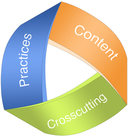In 2014, the State of Illinois adopted the Next Generation Science Standards (NGSS). Within the Next Generation Science Standards (NGSS), there are three distinct and equally important dimensions to learning science. These dimensions are combined to form each standard—or performance expectation—and each dimension works with the other two to help students build a cohesive understanding of science over time.
Science and Engineering Practices describe what scientists do to investigate the natural world and what engineers do to design and build systems. The practices better explain and extend what is meant by “inquiry” in science and the range of cognitive, social, and physical practices that it requires. Students engage in practices to build, deepen, and apply their knowledge of core ideas and crosscutting concepts.
Crosscutting Concepts help students explore connections across the four domains of science, including Physical Science, Life Science, Earth and Space Science, and Engineering Design. When these concepts, such as “cause and effect”, are made explicit for students, they can help students develop a coherent and scientifically-based view of the world around them.
Disciplinary Core Ideas (DCIs) are the key ideas in science that have broad importance within or across multiple science or engineering disciplines. These core ideas build on each other as students progress through grade levels and are grouped into the following four domains: Physical Science, Life Science, Earth and Space Science, and Engineering.
Science and Engineering Practices describe what scientists do to investigate the natural world and what engineers do to design and build systems. The practices better explain and extend what is meant by “inquiry” in science and the range of cognitive, social, and physical practices that it requires. Students engage in practices to build, deepen, and apply their knowledge of core ideas and crosscutting concepts.
Crosscutting Concepts help students explore connections across the four domains of science, including Physical Science, Life Science, Earth and Space Science, and Engineering Design. When these concepts, such as “cause and effect”, are made explicit for students, they can help students develop a coherent and scientifically-based view of the world around them.
Disciplinary Core Ideas (DCIs) are the key ideas in science that have broad importance within or across multiple science or engineering disciplines. These core ideas build on each other as students progress through grade levels and are grouped into the following four domains: Physical Science, Life Science, Earth and Space Science, and Engineering.

